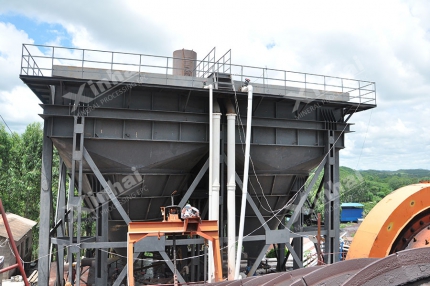Thickener tank is widely used for the dewatering of concentrates and concentration of tailings in dressing plants. They are mainly composed of thickening tank, rake, gearing device, rake lifting device, feeding device, unloading device and signal safety device. Taking Xinhai Mining Machinery Co., Ltd as an example, we will give you a brief introduction to thickener tank design.
As shown above, high-efficiency thickener tank design has two major part including rake-type mud scrapper and circular thickening tank. After the pulp with certain density is fed into the thickener by feeding device, the particles in the slurry will settle under the effect of gravity, while the clean water is on top, which achieves the solid-liquid separation. Besides, the thickening tank’s bottom is designed as a cone. The slurry deposited at the bottom is continuously scraped to the center of the tank bottom by rake-type mud scrapper and discharged by the outlet.
The gearing devices of thickener tank design can be divided into peripheral transmission and center transmission. Small-scale thickeners with 2 to18 m diameters are usually center transmission thickeners, whose rakes are majorly driven by center motors. By contrast, big-scale thickeners with 18 to 45 m diameters are equipped with peripheral transmission mode. As for this kind of thickeners, one end of the rakes is fixed in the center strut by means of special bearings, while the other end is linked to transmission trolley. The roller wheel on the trolley moves on the track, driven by an inner motor, reducer, gear, and rack, etc. So does the rake.
Xinhai has introduced America’s advanced production technology to its thickener tank design, not only adopting totally new-type mechanical structure but also strengthening the flocculation function to solid particles when designing. What’s more, according to customers requirement, Xinhai can supply flocculants feeding system, flocculants auto-control system and high-efficiency auto-control system for the thickeners.


 marketing@ytxinhai.com
marketing@ytxinhai.com  0086 13810327080
0086 13810327080 






































































































 CHAT
CHAT MESSAGE
MESSAGE

